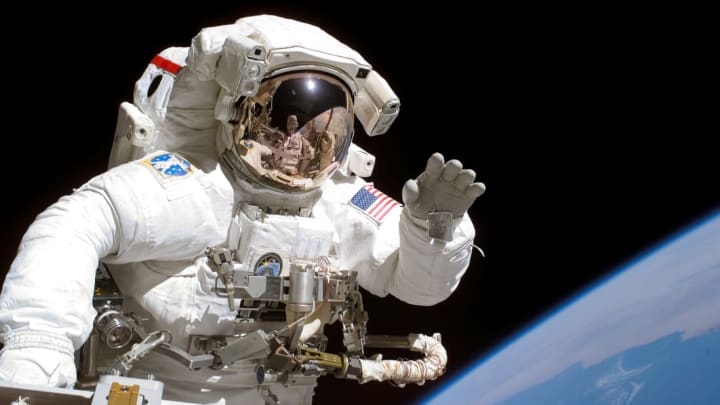What Happens When an Astronaut Gets Sick in Space?
By Kelly Doran

Astronauts are among the fittest and healthiest people in the world. They're rigorously trained, vetted, and quarantined before they’re allowed up in space—and yet, despite all those precautions, they do sometimes get sick. Apollo 13's Fred Haise, for example, had to deal with a painful kidney infection during the dangerous mission that gave us the phrase "Houston, we have a problem," and one-time astronaut Jake Garn, a Utah senator, got so motion-sick during a 1985 Discovery mission that astronauts now rate their nausea levels on the Garn Scale. And because space missions are on a strict schedule planned far in advance, sick astronauts on a space mission can't just pop down to Earth to see a doctor.
But when astronauts fall ill, they don't have to worry—NASA and other space agencies that have missions aboard the ISS are prepared.
SPACE ADAPTATION SICKNESS
Zero gravity can change a lot of normal bodily functions. One effect it has is to make the fluids inside the body float, which confuses the inner ears and makes them unable to tell up from down. This causes space adaptation syndrome (SAS), a common illness that's kind of like seasickness in space. Motion sickness, the most frequently reported ailment, is a subset of SAS; it affects 67 to 75 percent of astronauts.
It takes a few days for astronauts' bodies to adjust to weightlessness, during which they may experience symptoms ranging from headaches to vomiting. And though it might seem like a nightmare to deal with puke, NASA has a system: Astronauts carry special barf bags with attached face wipes and Ziploc seals that they can use during launch or while in orbit if they get the urge to hurl. Once used, the bags are tossed in the trash.
COLDS AND SNIFFLES
Because astronauts are quarantined before spaceflight, the likelihood of being exposed to a pathogen in space is rare. But if an astronaut does come down with the sniffles, they can expect an Earth cold on steroids: Sinuses don't drain in zero gravity, so congested astronauts feel even stuffier than we do here on the ground. To make matters worse, germs seem to thrive in weightless environments—pathogens can develop “thicker cell walls, greater resistance to antimicrobial agents and a greater ability to form so-called biofilms that cling to surfaces” in zero gravity, according to TIME.
Luckily, colds and even the flu tend to go away on their own, even in space—so astronauts just need to wait it out.
BUMPS, BRUISES, AND OTHER MINOR INJURIES
Astronauts floating around in zero gravity have a tendency to bump into things, which can sometimes cause an injury. When they want to check on a wound, abrasion, or another condition, they place a phone call to a physician on the ground, who will advise them what to do.
“We get calls for bumps, and bruises, and little lacerations or cuts,” Shannan Moynihan, deputy chief of space and occupational medicine at the NASA Johnson Space Center, said at a health tech conference in March 2018. “A typical scenario might be a newbie, somebody who just got up there, trying to Superman through a hatch and not quite making it. So we get a call for a little bump on the forehead and we help them figure out how to take care of that.”
A doctor on Earth can walk an astronaut through how to use and read a modified ultrasound machine on the ISS, for example, or give them additional training in response to a specific medical condition occurring on board. That happened with spaceflight-associated neuro-ocular syndrome, a condition in which ISS astronauts developed visual and structural changes in their eyes during space missions. They were subsequently trained to conduct a series of eye tests on themselves.
FROM EVACUATION TO SURGERY
If there’s anything too serious to deal with on board, astronauts can get back to Earth via the the Soyuz spacecraft that brought them to space—there’s always one docked at the ISS in case of emergency. Medical evacuation has only happened once, in 1986, when a Soviet astronaut named Vladimir Vasyutin had to leave the Salyut-7 Orbital Lab [PDF] because of a prostate infection. His trip back to Earth took about six hours; these days, astronauts can land in less than three and a half.
In the case of a true medical emergency—one that requires surgery—evacuation to Earth is currently the only way for astronauts to get treatment. Surgery in zero gravity isn't yet possible; blood would float straight out of a wound and contaminate the whole cabin. As deep space travel gets more feasible, however, it’s possible that one day a space O.R. might be necessary, and technology is being developed to make potential surgeries easier and cleaner. Scientists are testing a device called the aqueous immersion surgical system (AISS), a saline filled dome that, when placed over a wound, could keep blood and bodily fluids in place.
As humanity pushes further into deep space, medical technology will need to become even more sophisticated. When it comes to deep space missions, NASA representative Stephanie Schierholz tells Mental Floss, “NASA is specifically looking at five hazards of human space travel: space radiation, isolation and confinement, distance from Earth, gravity fields (or lack thereof), and hostile/closed environments that pose the greatest risks to the human mind and body in space.”
Currently, NASA is working on several research and development projects to address the hazards posed by deep space travel, including no-drill dentistry and emergency wound closure, which would need to be usable by astronauts with no formal medical or dental training. And because not all potential illness is physical, Mars settlement simulation projects are helping researchers understand what the psychological, emotional, and social effects of long-term isolation might be on astronauts.